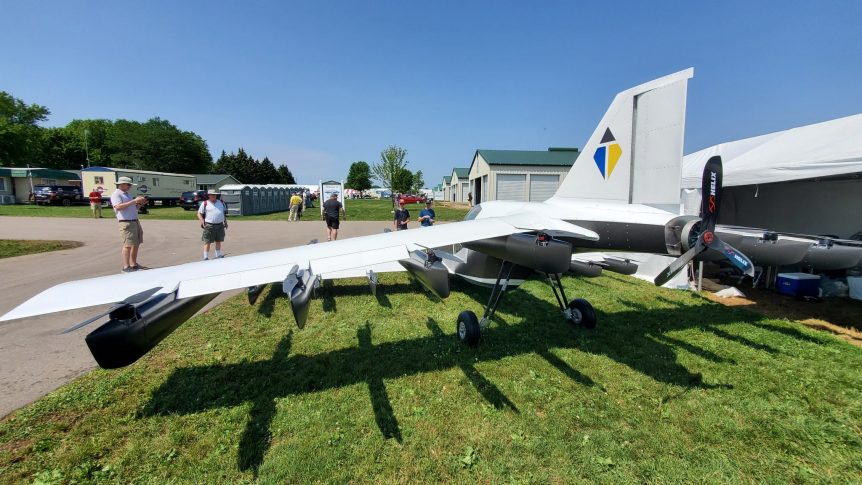A (Partially) Steam Engine in the Sky? Pratt & Whitney announces that it, “Has been selected by the U.S. Department of Energy (DoE) to develop novel, high-efficiency hydrogen-fueled propulsion technology for commercial aviation, as part of DoE’s Advanced Research Projects Agency-Energy (ARPA-E).” Their press release continues, “The Hydrogen Steam Injected, Inter‐Cooled Turbine Engine (HySIITE) project will use liquid hydrogen combustion and water vapor recovery to achieve zero in-flight CO2 emissions, while reducing nitrogen-oxide (NOx) emissions by up to 80 percent and reducing fuel consumption by up to 35 percent for next generation single-aisle aircraft.” P&W claims their HySIITE engine’s steam injection will “dramatically reduce” nitrogen oxide emissions, a greenhouse gas. “The semi-closed system architecture is claimed to have thermal efficiency “greater than fuel cells,” and have lower operating costs compared to “drop-in” sustainable aviation fuels (SAF). Steam Aircraft Engines Are Not New The Besler Brothers of Oakland, California demonstrated a Travel Air 2000 biplane powered by their steam engine. The …
The TeTra Mk. 5
The TeTra Mk. 5 is obviously not the first of its kind. A little history shows its origins in the Boeing GoFly completion – in which the team won a $100,000 “Disruptor” prize from Pratt & Whitney, the long-time engine makers. As stunning, and confusing, the appearance of their GoFly entry was, it did not prepare your editor for the 32-rotor (plus pusher propeller) single-seater shown flying in California recently. They flew SN2 of the Mk. 5 model in unpiloted mode, and will begin sales with serial number 3 at a yet unannounced price. One can speculate, though. Model aircraft motors such as the Hacker Q-100 cost 999 euros (about $1,163.00) each. (The makers have cleverly taped over the maker’s name on close-ups of the Oshkosh display model.) Even a lower-budget Chinese motor will cost around $500 each. An appropriate electronic speed controller (ESC) will be about half that of the motor. The 32-inch diameter carbon-fiber propellers would cost …
A Joyous Boxing Day Electrified
Boxing Day is a holiday unique to the British Empire, a day-after Christmas gift-giving celebration in which the well-off gave gifts to their servants. Yahoo Entertainment explains, “While there is some dispute over what the name actually means, it’s commonly believed that Boxing Day refers to the habit of aristocratic employees gifting their servants or tradesman on Dec. 26 as a thank you for their work throughout the year. The employers would give them each a box to take home to their family with gifts, bonuses and leftover food. “Samuel Pepys, a naval administrator and Member of Parliament, is famous for writing in his diary in 1663: ‘Thence by coach to my shoemaker’s and paid all there, and gave something to the boys’ box against Christmas.’” Certainly some regifting was in action, a chance for the upper class to get rid of fruitcakes sent by maiden aunts, or to reward particularly meritorious servants. In the spirit of Boxing Day, your …
Project 804 Turns Turboprop into Hybrid
Uniting Technologies United Technologies, an aerospace leader, expands its role as United Technologies Advanced Projects (UTAP), uniting Pratt & Whitney, Collins Aerospace, United Technologies Research Center “and certain as-yet-unannounced external institutions.” The organization’s Project 804. A hybrid-electric “X-plane” intended to reduce aircraft noise, improve fuel consumption, reduce carbon dioxide emissions and cut airline operating and maintenance costs. As exciting as the prospect sounds, the new aircraft probably won’t draw a lot of attention on the ramp. It will look pretty much like a DeHavilland Dash 8-400, a short-to-mid range passenger hauler at just about every commercial airport in the world. It is, indeed, a Dash 8, converted to a new and innovative hybrid-turbine power system. Entering service in 1984 as the Dash 8-100 carrying 37 passengers, the airplane went through different owners and models, reaching today’s 400 series that can haul up to 92 passengers. DeHavilland delivered 1,258 of all models as of March 31, 2019. Its ubiquity and solid …
Boeing and Embraer Embrace on Biofuels
Brazil may become a central research and manufacturing site for biofuels, with Boeing and Embraer opening a joint sustainable biofuel research center, something that will rely on Brazil’s fertile land to supply non-food plants with which to make jet fuel. Working in the Boeing-Embraer Joint Research Center in the São José dos Campos Technology Park, opened in January 2014, the companies are continuing to “focus on technologies that address gaps in creating a sustainable aviation biofuel industry in Brazil, such as feedstock production, techno-economic analysis, economic viability studies and processing technologies.” Boeing’s Research & Technology-Brazil (BR&T-Brazil) Center, one of the company’s six international advanced research centers, leads the collaboration with Embraer and works with Brazil’s research-and-development community “to grow Brazil’s capabilities and meet the country’s goals for economic and technology development while supporting the creation of innovative and affordable technologies for Boeing’s business units.” This is one of several biofuel development projects in the U. S., the Middle East, Africa, …




